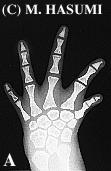
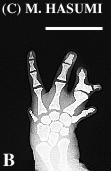
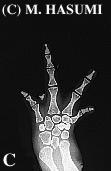
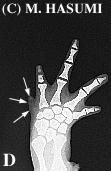
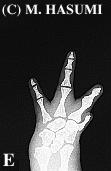
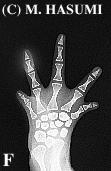
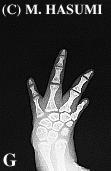
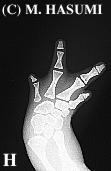
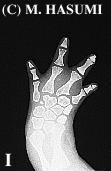
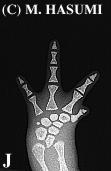
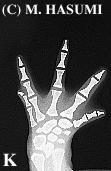
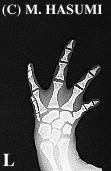
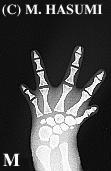
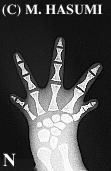
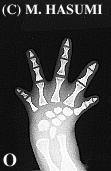
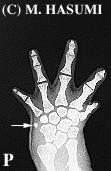
 |  |  |  |
 |  |  |  |
 |  |  |  |
 |  |  |  |
(A) Standard (see Fig. A; Pes Composition). A foot has a phalangeal formula of 22332 for the number of phalanges from the first toe to the last toe. The tarsus is composed of 10 tarsal elements: four tarsalia which consist of the enlarged tarsale 1+2 and the third, fourth, and fifth tarsalia; three centralia; tibiale; fibulare; and intermedium.
(B*) Anomaly. The deformed second toe has a branched large phalanx which rests upon the enlarged second metatarsal, the rudimentary fifth toe consists only of the very thin fifth metatarsal, the enlarged tarsale 1+2 and the first centrale are nearly fused, and the fifth tarsale and fibulare appear to be fused though their boundary is clear.
(C*) False tetradactyly without the fourth toe. A foot has a phalangeal formula of 22302 and no forth metatarsal, but the fourth tarsale is present.
(D*) False pentadactyly (arrows) with the underdeveloped fifth toe. A foot has a phalangeal formula of 22320 and no fifth metatarsal, although the fifth tarsale is normal.
(E*) Tetradactyly with six tarsal elements. A unique foot having six tarsal bones is composed of tarsale 1+2, the fused third and fourth tarsalia which support both the third and fourth metatarsals, the fused first centrale and tibiale, the fused second and third centralia, the fibulare, and the intermedium, and has a phalangeal formula of 12320.
(F) Pentadactyly with five centralia, appearing in the primitive tetrapods. A foot contains 12 tarsal bones, due to these five centralia.
(G) Tetradactyly with the same composition as that of H. hidamontanus. A foot has a phalangeal formula of 22320. The absence of the fifth metatarsal and two phalanges, revealing the complete absence of the fifth toe, is caused mostly by the absence of the fifth tarsale and partly by the fusion of the fourth and fifth tarsalia. In H. hidamontanus, although the rudimentary fifth metatarsal was found in two of 36 specimens (5.5%), none had the fifth toe, phalanx, and tarsale.
(H*) Tetradactyly with the fused third and fourth tarsalia. A foot has a phalangeal formula of 12210.
(I*) Tetradactyly with 11 tarsals including very tiny two. A foot has a phalangeal formula of 22220.
(J) Tetradactyly with the tiny fifth tarsale and the unossified first centrale and tibiale. A foot has a phalangeal formula of 12320.
(K*) Pentadactyly with the rudimentary fifth toe, despite its normal metatarsal and phalanges. The fusion of the third and fourth tarsalia results in the occurrence of the seemingly underdeveloped fifth toe, which normally consists of the fifth metatarsal and two phalanges close to the fourth metatarsal and three phalanges.
(L*) Pentadactyly with the rudimentary fifth metatarsal and phalanges.
(M*) Pentadactyly with the unossified tibiale.
(N) Pentadactyly with the unossified first centrale and tibiale.
(O*) Pentadactyly with the unossified fifth tarsale, first centrale, and tibiale. The unossification of the fifth tarsale does not influence the absence of the fifth metatarsal and two phalanges.
(P*) Pentadactyly with the postminimus (arrow), also appearing in the primitive tetrapods.